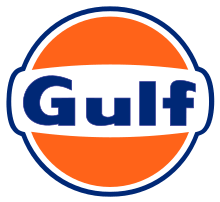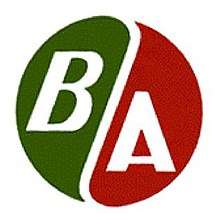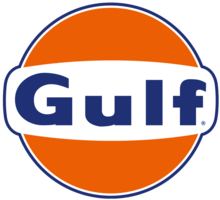Gulf Canada
Gulf Canada, originally British-American Oil and eventually Gulf Canada Resources, is a major Canadian integrated gas, oil, and resources company in operation since 1906. It was Canada's 4th largest oil company and operated over 9,000 retail gasoline outlets.
 | |
Formerly | British-American Oil (1906-1969) |
|---|---|
| Subsidiary, Independent | |
| Industry | Petroleum, Conglomerate |
| Fate | Downstream business in Ontario and Western Canada sold to Petro-Canada in 1985, then remaining downstream business in Quebec and Atlantic Canada sold to Ultramar in 1986 Gulf gas stations came back across Canada in 2015 |
| Founded | 1906 |
| Founder | Albert Leroy Ellsworth (as British-American Oil) |
| Headquarters | Burlington, Ontario, Canada |
| Parent | Gulf Oil ConocoPhillips Olympia and York |
| Website | gulfcanada.ca |
The company expanded rapidly through growth and acquisition to eventually be valued at over $6 billion.[1] It was a highly visible company that was the subject of controversial acquisition strategies, the federal government's efforts to Canadianize the oil and gas industry, and the failure of the world's largest property developer. At its peak, it was a diversified conglomerate whose assets included a major distillery company, the world's largest pulp and paper producer, a major pipeline, and Canada's largest natural gas distributor. In 2001, it was operated as Phillips 66 Canada. In 2015, Gulf Canada has returned to bring back Gulf gas stations across Canada with an expansion plan by inviting gas stations owners to join the Gulf banner.[2]
British-American Oil
The British-American Oil Company (B/A) was founded in Toronto, Ontario, in 1906 by Albert Leroy Ellsworth (1876–1950). He was born in Welland, Ontario, and had worked for 9 years at Standard Oil's Acme Refinery in Buffalo, New York. The company was organized with a Province of Ontario Charter dated October 17, 1906, and its first office building was located at the corner of King and Yonge Streets in Toronto.[3]
In 1908, with 8 shareholders, B/A built Canada's third refinery on 3 acres on the eastern waterfront in Toronto. The company refined imported crude oil and its main product was kerosene; a then-useless by-product was gasoline, which was dumped into a swamp. B/A acquired a Dominion Charter which allowed it to expand eastward into Quebec as well as west into other provinces. Expansion was swift, with the refinery expanding to 40 acres and crude oil production was up to 32,000 barrels per month. Most of the product was hauled on horse-drawn wagons and in wooden barrels by rail.[4]
In 1920 B/A purchased the Winnipeg Oil Company and established regional headquarters in Winnipeg, Manitoba. The company was by then marketing a variety of products, including gasoline, motor oil, benzene, anti-freeze, and others under a variety of brands, both in-house and from other companies. In 1924 B/A entered the U.S. as a producing company with the formation of the Toronto Pipeline Company. In 1925 B/A formed the British-American Oil Producing Company in Delaware to develop producing oil fields which were then being discovered in Oklahoma. It was a wholly owned subsidiary of B/A with operations confined to the United States.[4]
In 1922 Ellsworth, together with several partners, established the Clear Vision Pump Company Limited (CVPC) which amongst other products, was the first pump that provided a visual check of the gasoline being dispensed. CVPC acquired similar companies in Canada and the United States which led to the formation of the Service Station Equipment Company Limited in 1927, later renamed International Metal Industries Limited.[5][6]
In the 1930s, B/A established its own fleet of tanker ships to operate on the Great Lakes: The Britamoil (photo), the Britamolene, the Britamette, the Britamlube, and the Britamaco. B/A built Canada's first absorption plant at Longview, Alberta in 1934 to extract gasoline from "wet gas", a mixture of natural gas and gasoline. B/A also built pipelines from well-heads to refineries as well as purchasing several oil refineries in Alberta, and Saskatchewan. By 1938 B/A was constructing a new refinery in Calgary, Alberta, it operated 5 ocean tankers, 5 lake tankers, and 450 railway tank cars. B/A's subsidiaries extended into several U.S. states, including wells on the grounds of the Oklahoma State Capitol building.[4]

During the Second World War the Clarkson, Ontario plant was modified to produce aviation fuel, the B/A tanker fleet was redirected for cross-Atlantic service, and B/A completed the Montreal–Portland pipeline to provide year-round delivery of crude oil from Venezuela to the Montreal East Refinery. B/A constructed a gas re-pressurizing and recycling system at Longview, Alberta to conserve the declining resources of the Turner Valley Field. During construction of the Alaska Highway, B/A provided more than 100 large storage tanks at various locations along the highway to provide the U.S. Army Corps of Engineers with fuel. B/A expanded in the U.S. with wells near Casper, Wyoming. In 1946 B/A expanded its operations from coast to coast with the purchase of the Canadian assets of Union Oil Company of Canada, including the former British Columbia Refining Company Ltd. refinery in Port Moody, British Columbia, and its distribution network on the West Coast and Vancouver Island; and in 1946 began distribution of its products in Newfoundland.[3][4][7] After the war, the Gulf Oil Corporation acquired 20% ownership of B/A.
In the 1950s senior management at B/A became more integrated with Gulf Oil Corp as Gulf's ownership increased. New refineries were opened in Edmonton and Moose Jaw, and the company's tanker fleet expanded to 22. B/A constructed a new eight-storey headquarters building in Toronto. In 1955 the company's oil production reached a record 10.5 million barrels and its reserves of 113 million barrels of crude oil and 404 billion cubic feet of gas, with the total annual refinery output exceeding 33 million barrels.[4]
_(cropped).jpg)
During the 1940s, 1950's, and 1960's, in addition to petroleum products, B/A also issued its own credit cards, road maps, monthly Timely Station Topics Magazine and B/A Commentator Magazine, and sponsored a television game show.
In 1966 B/A sold its remaining US assets, the British-American Oil Producing Company, to Dallas-based Chared Corporation.[8]
Major acquisitions and new subsidiaries
- Royalite Petroleum Company Ltd., a major regional integrated petroleum producer and distributor in Western Canada and a pioneer in exploration, development, and production of the Athabasca tar sands, efforts which led to Royalite's (later B/A's and Gulf's) founding interest in the then-research consortium Syncrude in 1964.[9][10]
- Anglo-American Exploration Company Limited and its 700 Purity 99 service stations and outlets in Western Canada and Ontario from the Calgary-based Sam and Carl Nickel Group, in 1962.
- Canadian Helium Limited, in 1963. While drilling for oil, helium was discovered and a plant established near Swift Current, Saskatchewan. The company was established by B/A in partnership with British Oxygen and Canadian Liquid Air. At the time, it was one of the only deposits of helium in the free world, and also provided liquid nitrogen. The plant was capable of producing up to 36 million cubic feet of helium per year and operated until 1977.[11]
- Seventy-Seven Oils Limited of Alberta – propane, in 1964.
- Shawinigan Chemicals Ltd., from Gulf Oil Corporation, in 1968.[12]
Retail Operations
By the 1960s, B/A owned and operated over 9,300 service stations, approximately 25% of all stations in Canada. These were operated under names that included B/A, Anglo-Canadian, Purity 99, Red Head, and Royalite. B/A established the Purity 99 Oil Company Limited to manage the marketing of all of their stations; Royalite managed the service operations; and B/A the production and supply.[13]
Canadian Gulf Company
Prior to 1956, Gulf Oil Corp's operations in Canada were through its wholly owned subsidiary, Canadian Gulf Company. In 1956, it was merged with B/A in exchange for Gulf Oil obtaining a controlling interest in B/A, making the combined company the second largest producer of oil and the largest holder of natural gas reserves in Canada.[14]

In 1946, Gulf Oil Corporation of the United States acquired 20% ownership of B/A. In 1956, B/A acquired Canadian Gulf Oil Company in exchange for shares and US properties to Gulf Oil, giving it control of B/A with 64.8% of the shares. In 1969, B/A was renamed Gulf Oil Canada Ltd. and all of its subsidiary brands and retail outlets were re-branded with the orange and blue Gulf Oil logo. In 1978, the company was renamed Gulf Canada Ltd.. In July 1987, Gulf Canada Ltd. was renamed Gulf Canada Resource Ltd.[15]
Olympia and York
In late 1985 Chevron Corporation, which had the previous year purchased Gulf Oil, Gulf Canada's parent company, announced a series of transactions for the sale of its shares in Gulf Canada. This was done in part to fulfill promises to the Canadian government as part of its approval for Chevron's purchase of Gulf Canada.[16] In August 1985, Gulf Canada bought 90% of Abitibi-Price from the Montreal-based Reichmann family at the same time as the Reichmann's Olympia and York Developments bought 49.9% of GC from Chevron Corp. At the time, the $2.2 billion takeover was the largest corporate takeover in Canadian history. O&Y later purchased the remaining production, refining, and distribution assets through its new wholly owned subsidiary, Gulf Canada Corporation (GCC). At the time of purchase, GCC owned 2,500 service stations across Canada, was the third-largest oil producer and sixth-largest gas producer in the country, owned three Canadian refineries outright and has a half interest in a fourth, was also active in the Hibernia oil field off Newfoundland and in the Beaufort Sea in the Arctic.[17][18]
On September 30, 1985, Gulf Canada sold its downstream business located west of Quebec (including its refining, transportation, and marketing assets, but excluding the Edmonton refinery) for C$900 million to Petro-Canada.[19] On January 1, 1986, Gulf Canada sold its remaining downstream business located east of Ontario to Ultramar for C$86 million.[20] This included the Montreal East Refinery which was closed almost immediately.[21]
In early 1986 the corporate offices of GCC were relocated to Calgary.
Tax controversy
O&Y's complex purchase utilized an accounting strategy, known as the Little Egypt Bump, designed to take advantage of Canadian federal tax rules governing partnerships. The deal became publicly controversial and Leader of the Opposition John Turner alleged in Parliament that the deal cost Canadian taxpayers $1 billion in lost tax revenue. Others estimated the cost at $500 million.[16] Allegations of conflict of interest were made against a former federal deputy minister of finance who resigned from the government to work for the Reichmann family during O&Y's purchase and tax negotiations with the government.[22]
Operations and acquisition
In March 1986, GCC launched a takeover bid for Hiram Walker Resources (HWR), a distillery company (Gooderham & Worts) with significant assets in the oil and gas industry: Home Oil Company Ltd., with major assets in North America, the North Sea, Indonesia, and Australia; Consumer's Gas Company Ltd., a major gas distribution utility; and the largest ownership stake in Interprovincial Pipeline Ltd.. In a complex battle of hostile takeover attempts, "white knight" defenses, and legal action involving GCC, HWR, Allied Lyons, Elders IXL, and TransCanada Pipelines on three continents, GCC was ultimately successful in purchasing HWR. HWR's liquor distillation business was later sold to Allied Lyons.[23]
In 1986, GCC discovered the largest oil field then discovered in the Beaufort Sea and a few months later shut its operations there because of the high cost of operating in the harsh Arctic environment and the depressed price of oil.[24]
In 1988, GCC purchased Asamera Inc., an oil, natural gas and gold producer, for C$512 million, or about US$413 million. Calgary, Alberta-based Asamera had interests in oil- and gas-producing properties in Indonesia; exploration properties in Canada, the North Sea, Colombia and Italy; and a 51% stake in the Cannon gold mine in Washington state.[25]
Gulf Canada Resources
In 1992, GCC's parent company O&Y faced collapse due to an overwhelming debt burden and was taken over by a group of creditor banks with assistance from the Canadian government. As part of the subsequent restructuring, GCC, with assets of C$6.6 billion (US$5.5 billion) was split into three companies with shares offered to existing shareholders:
- Gulf Canada Resources Ltd. (GCR), formerly GCC, was restructured into a pure oil and gas company.
- Abitibi-Price, then the world's largest newsprint maker.
- GW Utilities Ltd., whose assets included a 49% percent stake in distilling company Hiram Walker-Gooderham and Worts Ltd.; 83% of Consumers Gas Company (Canada's largest natural gas distributor); and 41% of pipeline operator Interprovincial Pipe Line Ltd. (IPL). (In 1992, IPL purchased Consumers and the combined company is now known as Enbridge).
In 1996, GCR formed the Athabasca Oil Sands Trust with an 11.74% interest in Syncrude. The trust was later merged to form Canadian Oil Sands.[26]
The 2000 purchase of Crestar Energy Inc. substantially increased GCR's production assets, raised it to the top 5 Canadian producers and top 10 independent producers in North America, and gave it a significant stake in oil fields in eastern Ecuador.[27]
ConocoPhillips
In May 2001, Gulf Canada Resources Ltd. was purchased by Conoco Northern Inc., an indirect wholly owned subsidiary of Texas-based Conoco Inc. for C$6.7 billion (US$4.33 billion). It was known as Conoco Canada Resources Limited.[1][28][29]
Gulf returning to Canada
Since 2009, Teklub Canada Ltd is the official distributor of Gulf Oil International Ltd for Gulf branded lubricants in Canada.
Gulf retail operations in Canada re-emerged beginning in 2015 with conversion of XTR Energy Company stations to the Gulf brand under a licensing agreement with Gulf Oil International UK Limited.[2]
References
- Conoco Reaches Deal to Buy Gulf Canada for $4.33 Billion, Wall Street Journal, May 30, 2001. Retrieved 2015-04-07
- "Gulf brand gas stations returning to Canada after 30 years". The Globe and Mail. June 11, 2015.
- Canada's Early Oil Industry - A Brief History, Petroleum History Society, Archives Newsletter June 2000. Retrieved 2015-04-07
- History of British American Oil. Retrieved 2015-04-07
- The Montreal Gazette, October 17, 1928. Retrieved 2015-04-07
- Wilkins, Mira, The History of Foreign Investment in the United States, 1914–1945, Chapter 5, note 333. Harvard University Press, 2004. ISBN 978-0674013087. Retrieved 2015-04-07.
- City of Port Moody, Minutes - Regular Meeting of Council, September 11, 2012. Retrieved 2015-04-07
- 446 F. 2d 745 - Chared Corporation v. United States, Open Jurist. Retrieved 2015-04-07
- G.R.(Ron) Gray, Petroleum History Society, Oil Sands Oral History Project, interview. Retrieved 2015-04-07
- Historical Overview of the Fort McMurray Area and Oil Sands Industry in Northeastern Alberta, Alberta Energy Utilities Board, May 2000 Archived 2008-02-27 at the Wayback Machine. Retrieved 2015-04-07
- Swift Current Online. Retrieved 2015-04-07
- Archives Canada Archived 2015-04-17 at the Wayback Machine. Retrieved 2015-04-08
- Royalite Oil Company Ltd., Alberta Online Encyclopedia. Retrieved 2015-04-05
- Wood Gundy in The Montreal Gazette, May 10, 1956. Retrieved 2015-04-07
- Gulf Canada Resources. Retrieved 2015-04-07
- Narayanan, V.G. and Huddard, Steven. School of Business, Stanford University, April 1988. Retrieved 2015-04-05
- Article Excerpt of UPI story May 24, 1985. Retrieved 2015-04-07
- Chevron To Sell Gulf Canada, Chicago Tribune, May 24, 1985. Retrieved 2015-04-07
- Petro-Canada Will Buy Part of Gulf Canada, LA Times, August 14, 1985. Retrieved 2015-04-09
- Gulf Canada, New York Times. December 4, 1985. Retrieved 2015-04-04
- Montreal refinery closure approved, The Ottawa Citizen, December 7, 2005. Retrieved 2015-04-08
- The Montreal Gazette, October 23, 1985. Retrieved 2015-04-07
- History of Hiram Walker Resources, Reference For Business. Retrieved 2015-04-07
- Gulf Canada Shuts Operations In Beaufort Sea, August 25, 1986. Retrieved 2015-04-07
- Gulf Canada Resources To Acquire Asamera, New York Times, March 29, 1989. Retrieved 2015-04-07
- Canadian Oil Sands, History. Retrieved 2-15-04-08
- Gulf Canada-Crestar tops Canadian M&A frenzy, Oil and Gas Journal, 10/09/2000. Retrieved 2015-04-07
- Canadian Corporate Reports, McGill Digital Archive Retrieved 2015-04-07.
- Conoco's takeover of Gulf Canada leads latest merger wave, Oil and Gas Journal, June 4, 2001. Retrieved 2015-04-07
External links
- Official website
- www.gulfoil.ca